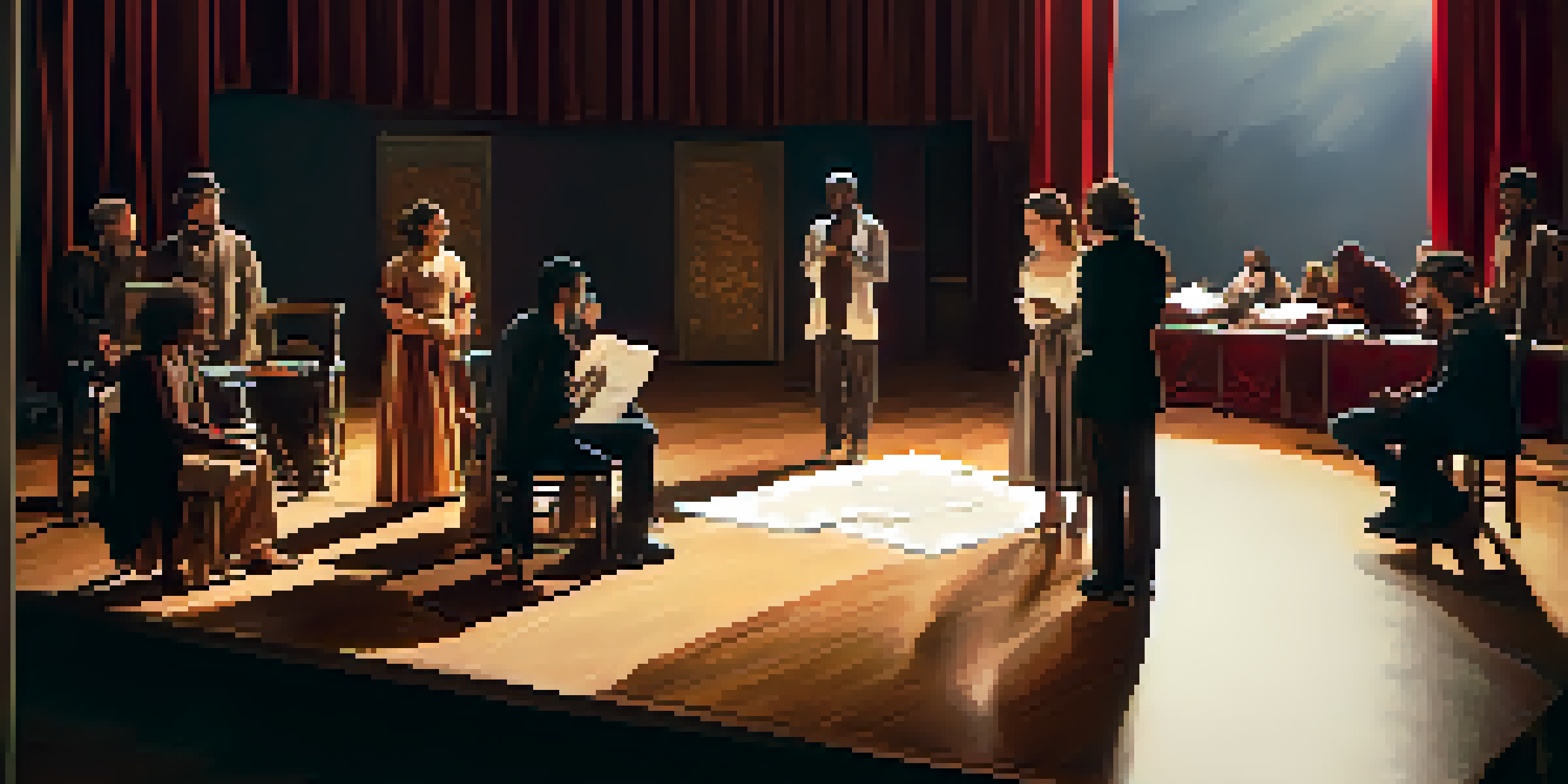The Stanislavski System: Foundations of Modern Acting Techniques

Introduction to the Stanislavski System
The Stanislavski System, pioneered by Konstantin Stanislavski in the early 20th century, revolutionized acting. This methodology shifted the focus from external performance to internal authenticity, encouraging actors to tap into their own emotions. The system emphasizes the importance of understanding a character's motivations and backstory, creating a more relatable and believable performance.
Acting is not about being someone different. It's finding the similarity in what is apparently different, then finding myself in there.
Before Stanislavski, acting often relied on exaggerated gestures and melodrama. However, his approach advocated for a more naturalistic style, where the actor's emotional truth is paramount. This change laid the groundwork for modern acting techniques, influencing countless actors and directors across the globe.
As we delve deeper into the components of the Stanislavski System, we’ll discover how this foundation continues to shape the craft of acting today. From method acting to various improvisational techniques, its legacy endures in contemporary theater and film.
Key Principles of the Stanislavski System
At the heart of the Stanislavski System are several key principles that guide actors in their craft. One of the most important is the idea of 'emotional truth,' where performers must connect with their character's feelings as if they were experiencing them in real life. This approach not only enhances performances but also resonates deeply with audiences.

Another vital principle is 'the magic if,' which encourages actors to imagine how they would react in their character's situation. This imaginative exercise helps bridge the gap between the actor's personal experiences and the character's circumstances, fostering a more authentic portrayal.
Emotional Truth in Acting
The Stanislavski System emphasizes the importance of emotional truth, encouraging actors to connect deeply with their characters' feelings.
Lastly, the concept of 'given circumstances' is crucial. Actors must understand the context of their character's world, including their relationships, history, and environment. By thoroughly grounding their performances in these circumstances, actors can create a richer, more believable narrative on stage or screen.
The Role of Observation in Acting
Observation is a vital component of the Stanislavski System. Stanislavski believed that actors should study real life, paying close attention to how people behave, interact, and express emotions. This practice allows performers to draw inspiration from genuine human behavior, making their portrayals more relatable.
The best actors are not the ones who are most talented, but those who are most willing to connect with their own feelings.
Through careful observation, actors can develop a nuanced understanding of various emotional states and social dynamics. For instance, watching how friends communicate during a moment of conflict can inform how a character might react in a similar situation. This attention to detail enriches the actor's repertoire and enhances the depth of their performances.
Moreover, observation extends beyond just people; it also includes studying nature and its rhythms. By understanding the world around them, actors can better embody their characters, bringing a sense of authenticity that captivates audiences.
The Importance of Relaxation Techniques
Relaxation is a cornerstone of the Stanislavski System, as it allows actors to access their emotions without artificial barriers. Tension can hinder performance, so Stanislavski emphasized various relaxation techniques to help performers release physical and mental stress. This state of relaxation opens the door to emotional exploration and responsiveness on stage.
One common technique involves deep breathing exercises that calm the mind and body, preparing actors to step into their characters with clarity. By adopting a relaxed posture and mindset, actors can connect more profoundly with their roles, enhancing their overall performance.
Role of Observation
Observation of real-life behaviors and emotions is crucial in the Stanislavski System, helping actors create relatable and authentic performances.
Additionally, relaxation exercises help create a supportive environment during rehearsals and performances. When actors feel at ease, they are more likely to take risks, respond authentically to their fellow performers, and ultimately deliver a powerful portrayal that resonates with the audience.
Developing Character through Sense Memory
Sense memory is a technique within the Stanislavski System that enables actors to evoke genuine emotions and reactions. By recalling personal experiences tied to specific senses—like smell, touch, or sound—actors can create a more profound connection to their characters. This method encourages performers to draw from their own lives, making their portrayals more authentic.
For example, an actor may remember the smell of fresh bread from their childhood to evoke feelings of warmth and comfort, which can then be translated into their character's emotional state. This technique not only deepens the actor's understanding of their role but also enriches the audience's experience as they witness these authentic emotions unfold.
Moreover, sense memory can help actors overcome the challenges of portraying emotions that may be difficult to access. By tapping into their own memories, they can find relatable touchpoints that resonate with their character's journey, creating a compelling performance.
Improvisation and Its Role in the System
Improvisation is an essential tool within the Stanislavski System, allowing actors to explore their characters in a spontaneous and organic manner. This practice encourages creativity and adaptability, enabling performers to react authentically to unexpected situations. By engaging in improvisational exercises, actors can discover new facets of their characters and deepen their understanding of the material.
For instance, improvisation can help actors build chemistry with their fellow performers, fostering a sense of trust and collaboration on stage. When actors feel free to experiment and take risks, the resulting performances often feel more genuine and engaging to the audience.
Impact on Modern Techniques
The Stanislavski System has profoundly influenced modern acting methods, shaping the craft of contemporary actors through its focus on emotional authenticity.
Additionally, improvisation hones an actor's ability to stay present in the moment. In live performances, unexpected events can occur, and being skilled in improvisation allows actors to navigate these challenges gracefully, ensuring that the show goes on without a hitch.
Impact of the Stanislavski System on Modern Acting
The influence of the Stanislavski System on modern acting techniques is profound and far-reaching. Many contemporary approaches, such as method acting and Meisner technique, draw heavily from Stanislavski's principles. These techniques emphasize emotional authenticity, character immersion, and the importance of personal experience in performance.
Prominent actors like Marlon Brando and Robert De Niro have famously utilized elements of the Stanislavski System in their craft, leading to performances that are both powerful and relatable. Their ability to connect emotionally with their characters has set a benchmark in the industry, inspiring countless actors to follow suit.

Moreover, Stanislavski's teachings have permeated acting schools and training programs worldwide, ensuring that his legacy endures. As aspiring actors continue to embrace these principles, the impact of the Stanislavski System will undoubtedly shape the future of performance art for generations to come.